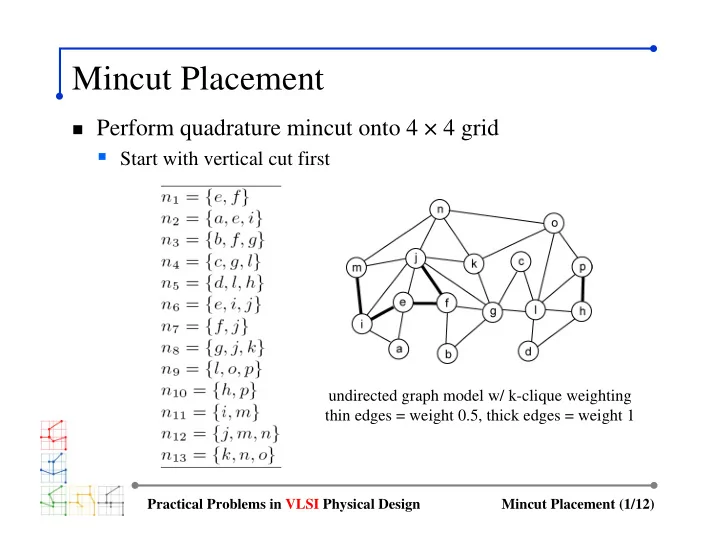

Mincut Placement � Perform quadrature mincut onto 4 × 4 grid � Start with vertical cut first undirected graph model w/ k-clique weighting thin edges = weight 0.5, thick edges = weight 1 Practical Problems in VLSI Physical Design Mincut Placement (1/12)
Cut 1 and 2 � First cut has min-cutsize of 3 (not unique) � Both cuts 1 and 2 divide the entire chip Practical Problems in VLSI Physical Design Mincut Placement (2/12)
Cut 3 and 4 � Each cut minimizes cutsize � Helps reduce overall wirelength Practical Problems in VLSI Physical Design Mincut Placement (3/12)
Cut 5 and 6 � 16 partitions generated by 6 cuts � HPBB wirelength = 27 Practical Problems in VLSI Physical Design Mincut Placement (4/12)
Recursive Bisection � Start with vertical cut � Perform terminal propagation with middle third window Practical Problems in VLSI Physical Design Mincut Placement (5/12)
Cut 3: Terminal Propagation � Two terminals are propagated and are “pulling” nodes � Node k and o connect to n and j : p 1 propagated (outside window) � Node g connect to j, f and b : p 2 propagated (outside window) � Terminal p 1 pulls k / o / g to top partition, and p 2 pulls g to bottom Practical Problems in VLSI Physical Design Mincut Placement (6/12)
Cut 4: Terminal Propagation � One terminal propagated � Node n and j connect to o / k / g : p 1 propagated � Node i and j connect to e / f / a : no propagation (inside window) � Terminal p 1 pulls n and j to right partition Practical Problems in VLSI Physical Design Mincut Placement (7/12)
Cut 5: Terminal Propagation � Three terminals propagated � Node i propagated to p 1 , j to p 2 , and g to p 3 � Terminal p 1 pulls e and a to left partition � Terminal p 2 and p 3 pull f / b / e to right partition Practical Problems in VLSI Physical Design Mincut Placement (8/12)
Cut 6: Terminal Propagation � One terminal propagated � Node n and j are propagated to p 1 � Terminal p 1 pulls o and k to left partition Practical Problems in VLSI Physical Design Mincut Placement (9/12)
Cut 7: Terminal Propagation � Three terminals propagated � Node j / f / b propagated to p 1 , o / k to p 2 , and h / p to p 3 � Terminal p 1 and p 2 pull g and l to left partition � Terminal p 3 pull l and d to right partition Practical Problems in VLSI Physical Design Mincut Placement (10/12)
Cut 8 to 15 � 16 partitions generated by 15 cuts � HPBB wirelength = 23 Practical Problems in VLSI Physical Design Mincut Placement (11/12)
Comparison � Quadrature vs recursive bisection + terminal propagation � Number of cuts: 6 vs 15 � Wirelength: 27 vs 23 Practical Problems in VLSI Physical Design Mincut Placement (12/12)
Recommend
More recommend